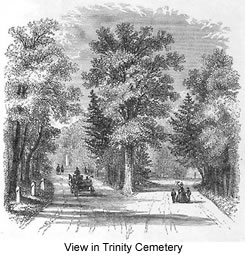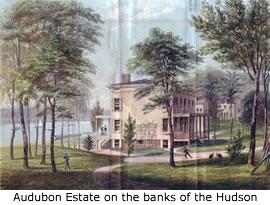Trinity Cemetery helped to shape the history of northern Manhattan to what it is today. Many of the persons whose remains are interred here shaped not only the history of the area but that of the United States.
 The area’s first claim to history was on November 16, 1776, as the second line of defense during the Battle of Fort Washington. On that fateful day, the vastly outnumbered Rebel army was forced back by the British forces from the south.
The area’s first claim to history was on November 16, 1776, as the second line of defense during the Battle of Fort Washington. On that fateful day, the vastly outnumbered Rebel army was forced back by the British forces from the south.
After the war, the land was bought into private ownership. The last person to privately own the property was John James Audubon, the naturalist, who bought the land in 1839.
In 1842 Trinity Parish purchased part of the Audubon estate. This newly purchased area (24 acres) extended from 153rd to 155th Streets and from Amsterdam Avenue to Riverside Drive. The newly formed cemetery was established as a result of an ordinance passed by New York City prohibiting any further burials in lower Manhattan due to the fact that overcrowding in the existing cemeteries was the result of deaths caused by smallpox, typhoid, and cholera. These were creating unsanitary conditions due to the high mortality rate. The first burial took place a year after the purchase.
As time passed, Broadway was extended northward. The cemetery was forced to exhume graves and relocate them toward the Hudson River to make way for the newly expanded boulevard. The cemetery as we know it today is now divided into two divisions. The western division contains a majority of the older grave sites and mausoleums dating from 1843. The eastern division has more recent mausoleums and graves. Since the late 1970s, new mausoleums have been built along the Riverside Drive side of the cemetery. Near these newly created mausoleums is a small artificial pond with miniature Canadian Geese and European Shell Ducks.
In 1989, a gate and stairway were built to access the cemetery from Riverside Drive. In 1871, a bridge was built to connect both sides of the cemetery. The architects were Vaux, Withers and Co., the engineer was George C. Radford. The bridge was torn down in 1913 when construction of the Church of the Intercession was in progress.
On Amsterdam Avenue and 153rd Street is the cemetery lodge, which had been built in 1883 as a residence for the groundskeeper. The house is still used today by the employees of Trinity Cemetery as an office.
Many of the mausoleums, graves, vault markers, and monuments were erected by many of New York’s 19th and 20th Century High Society. Most of these were lavishly built for them in death to show how they lived in life. As one goes through Trinity, some of the finest examples of Neo-Gothic, Victorian and American Vernacular art and architecture for a graveyard can be found. It is wise to note that some of the mausoleums and vaults are not marked so as to ensure the privacy of those interred, as well as to prevent grave robbing.
Different types of stone were used to construct the graves and mausoleums. Marble, brownstone, and granite can only be found in various spots in the cemetery. As most people are aware, marble starts to wear down over the years, with lettering and ornaments starting to fade. Brownstone fares worse: after years of exposure, it peels and crumbles. Mausoleums made of brownstone have a tendency of being broken at the edges just by using fingernails. Newer mausoleums in the western division have granite facing, which has a longer lifespan than its predecessors.
As mentioned before, Trinity is home to New York’s social elite of the past. One such example of someone here is Alfred Tennyson Dickens, the son of Charles Dickens, who had come to New York to coordinate the centennial of his father’s birth. On the eve of the celebration, Dickens suffered a fatal heart attack at the Hotel Astor and died. Since Dickens did not have next of kin in America, he was buried at the cemetery with a gravestone donated by Trinity Parish.
 John James Audubon (1780-1851), artist and naturalist, is best noted for his life-sized paintings of birds. Audubon’s grave is in the eastern division, behind the Church of the Intercession. The New York Academy of Sciences erected a memorial in 1893 that is a fitting tribute to Audubon. On both sides of the memorial are likenesses of his work topped with a Celtic cross.
John James Audubon (1780-1851), artist and naturalist, is best noted for his life-sized paintings of birds. Audubon’s grave is in the eastern division, behind the Church of the Intercession. The New York Academy of Sciences erected a memorial in 1893 that is a fitting tribute to Audubon. On both sides of the memorial are likenesses of his work topped with a Celtic cross.
Clement Clarke Moore (1779-1863) is located in the western half of the cemetery. He is well known as the author of the poem “A Visit From Saint Nicholas,” which was written for his children as a Christmas present and was eventually published. Moore was the son of Dr. Benjamin Moore, the sixth Rector of Trinity Parish.
The Astor family has various members interred at Trinity. John Jacob Astor (1763-1848) started a fur and musical instrument business in New York. With the money the family earned, they bought property that later included the Hotel Astor and the Waldorf-Astoria. His son, William Blockhouse Astor, is also buried there.
Eliza Jumel, of Morris-Jumel Mansion fame, is interred here too. Her colorful life and marriages to Stephen Jumel and Aaron Burr made her quite notorious in the New York social circles. As a matter of fact, neither one of her husbands is buried with her in the mausoleum.
As one walks through the cemetery and knows the history of New York City, some interesting names appear on the gravestones. For example, two of New York City’s mayors are buried here: Fernando Wood and A. Oakley Hall. The Right Reverend Benjamin Tredwell Onderdonk, the fourth Bishop of New York, is laid to rest here.
Some of the residents of northern Manhattan are buried here as well. These are the Guanos and the Carmans. Richard F. Carman owned the property from 139th to154th Streets and Saint Nicholas Avenue to the Hudson River. Some of the tenants who lived in the area called it “Chapmanville.” William Guano was another resident who owned property in Washington Heights and is buried here too.
In 1969, the cemetery was designated as a historic landmark, thus halting all in-ground burials with the exception of direct descendants of those already interred here, such as the Astors if they so choose. At present, there are at least 32,000 people buried in both divisions of Trinity Cemetery.
Located at 155th and Broadway is the Church of the Intercession, which was constructed between 1911 and 1914. It is the finest example of Neo-Gothic architecture in New York City. The architect of the church is Bertram Governor Goodhue, who is buried within the church. Every Christmas the church celebrates the Clement Clarke Moore Candlelight Carol Service, honoring the poet who wrote “A Visit From Saint Nicholas,” which has become a tradition since 1911 when Reverend Milo Gates started it.
For more information on Trinity Cemetery, call (212) 602-0787 or (212) 368-1600. The Church of the Intercession can be reached at (212) 283-6200. For more information about the Episcopal Church, visit its Web site. Trinity Church can be reached at (212) 602-0800.
